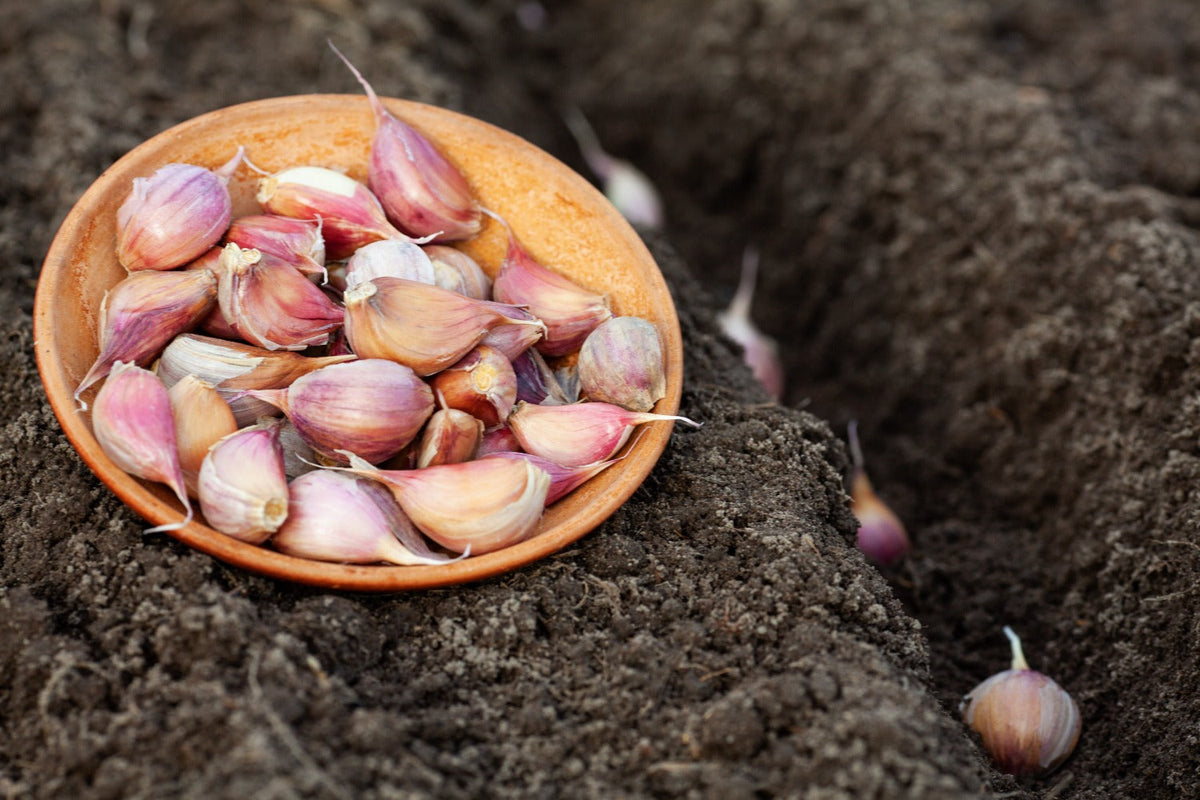
Planting garlic: our tips for a successful harvest
|
Tijd nodig om dit artikel te lezen: 4 min
|
Tijd nodig om dit artikel te lezen: 4 min
Autumn has started. And although it may not immediately occur to you, it is time to plant garlic from October. Because planting in October means harvesting in June and July next year. But how do you do that? What do you need to take into account? We give you tips below!
The ideal time to plant garlic is October. The ground is still warm enough and it gets colder and wetter outside. But don't get crazy. It is also possible to plant garlic in November . As long as the ground is not frozen, you can get started. But why is it so important to plant garlic in the fall? Simple: the cloves need a period of cold, a certain number of days of low temperatures , to become thicker in the spring. Without that period of cold, no thick garlic bulbs.
Garlic is a crop with a manual. Not difficult, but there are a few things you need to take into account. For example, the soil is a very important factor for successful cultivation. Garlic needs a soil that drains well . It hates stagnant water and even goes moldy and rotten when that is the case. A sand and sandy loam/loam soil is fine. Wet clay soils are a challenge. Then it can be useful to grow your garlic in raised beds. You can easily fill these with compost, peat-free potting soil and sand, a very good combination to prevent stagnant water .
Now that it is clear in which conditions garlic grows best, it is time to plant (or plant, as it is called in technical terms). How to do this is simple, there is even a good mnemonic for it. 10/10/10 : this means that you plant garlic in October, about 10 centimetres apart and 10 centimetres deep. Easy, right? Incidentally, you plant the cloves of garlic, not the entire bulb. Because one clove will become one large bulb with multiple cloves next year. Put the cloves about 10 centimetres deep , so that they are firmly in the ground and will soon become large bulbs. Water, or wait until Mother Nature opens the floodgates.
Make sure you buy plant garlic. Avoid garlic from the supermarket, because they are often imported from abroad . In theory you can also plant those cloves, but experience shows that those types of varieties come from warmer and drier areas and are therefore not really able to cope with our wet winters. Plant garlic can be found everywhere in the fall. Such varieties are better adapted and also have a greater chance of success.
What happens next? We have put our cloves in the ground, but what should happen next? Above all, be patient. The garlic will still form shoots in the first weeks after planting. You will then see green shoots sticking out above the ground. Shoots that are reminiscent of chives or young onions and shallots. That is completely normal. The plant will grow briefly and go into dormancy during the winter months. You will then not see the plant grow anymore until the weather gets warmer in March. Then the plant makes a growth spurt and the bulb gradually becomes thicker due to the days that get longer and the temperature that rises in the air. From June and July the foliage of the plant becomes yellowish, the time to harvest. Incidentally, the foliage should not be completely brown, as is the case with onions and shallots.
Don't leave the ground uncovered during the winter months. That's a shame, and also not good for soil life. Mulch with straw, finely chopped garden and pruning waste and leaves: as long as it keeps your ground covered. That works like a blanket between your plants, and that is not an unnecessary luxury with this plant.
Did you know that there are special varieties besides the regular varieties? For example, there is elephant garlic. A type that produces such large garlic bulbs that the reference to an elephant is not at all crazy. The taste is slightly milder than the regular varieties, despite the fact that the cloves are much larger. A recommendation to experiment with and now quite common online or from growers.
Not everyone has a large vegetable garden. Sometimes green fingers also itch in the city, on a terrace or balcony. Good news, because garlic can also be kept in a pot ! Sounds crazy? No, it is actually very logical. In the pot you can perfectly control that no water remains stagnant. With a drainage hole that is almost impossible. Yes, the bulbs will eventually remain a little smaller, but that is not a problem at all. Keep watering during the winter months, because a dry growing environment is disastrous for garlic. Also make sure that the pot is sturdy enough and not porous, as is the case with many terracotta pots. You do not want the pot to crack. Avoid leaving the pot in an overfull saucer during very wet periods. Remove the saucer or turn it upside down, so that the excess water can easily drain away.
Did you know that we also have a well-stocked YouTube channel? With over 450 videos, we have a large database of information. Be sure to check out YouTube and subscribe, so you can stay up to date with the latest videos.
In this video Angelo shows you step by step how to plant garlic in a pot yourself. He gives tips for a successful harvest on your terrace or balcony .







